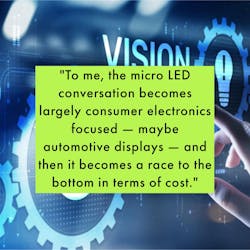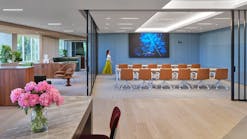INTERVIEW | Cree LED CEO says application-specific innovation is key to long-term strategy
After parent company SGH had reported a period of pandemic- and supply-chain–driven slowdowns impacting the LED Solutions business, it recently announced improved performance for Cree LED in its first two quarters of fiscal year 2024.
While noting the “muted” demand environment for LEDs during an April earnings call, SGH CEO Mark Adams said he expected demand trends to continue upward, and that “given our strong R&D and IP portfolio combined with our capital light outsource model, I’m confident in Cree LED’s competitiveness and prospects for future success.”
Indeed, over the past year, the LED developer took up occupancy in an 85,000-plus square-foot facility combining laboratory, pilot production, and operations teams into one space. All this took place while it released multiple LEDs targeted toward high-efficacy and high color-quality applications, such as indoor and outdoor directional lighting and large-format displays — four of which received LEDs Magazine BrightStar Awards recognition in 2024.
LEDs editor-in-chief Carrie Meadows recently sat down with Cree LED president Joe Clark to discuss in more detail factors that contributed to sales recovery, the unit’s development and outsourcing approaches, and prospects for advances such as micro LEDs.
LEDs Magazine: The first fiscal quarter (end Dec. 1) sales for Cree LED were up 11.5%. Then again in 2Q24, sales rose by 8% compared to a year ago. To what do you credit this recovery?
Joe Clark: There are a number of factors. The market was down pretty dramatically in FY23. At that point, we saw excess inventory. That inventory — both our customers’ and within our own channel — has largely been burned off and things are in a much more stable, sensible place.
We’ve also refocused our team. You alluded to our move to a new site, so a lot of activity was happening around that. It was not specific to the customer-facing nature of the business, but now we’re refocused and getting good traction with key customers. We’re also identifying new customers or old customers that we are going back to and rekindling relationships. That has been a positive influence on the most recent numbers.
LEDs: How has the change to an outsourced manufacturing model been going, and how has it affected Cree LED’s results from these past two quarters?
Clark: It’s going quite well. It certainly allowed us to serve customer demand effectively and allowed us to maintain our focus and energy where it really needs to be, which is on innovation. We’ve been able to do that while minimizing capital expenditures and other costs. It’s a model that’s pretty unique to us within the LED business.
LEDs: Do you have any plans to modify other parts of your operation in an outsourcing model?
Clark: Yes, we’re constantly working with our outsource partners, evaluating what’s available out there, where we should be geographically. Also, what technology we need to be pairing up with and utilizing, and how we get the best result for our customers. Our objective is always to use our technology and innovation to the best advantage for ourselves and our stakeholders.
LEDs: What kinds of products or trends are you seeing in terms of demographics? During another interview, Inventronics representatives talked about the difference between what they’re offering for Europe versus what they’re planning to offer for North America. It’s an interesting conversation to open up with different players in the supply chain.
Clark: We see different needs in different places. Some of it depends on how we do our business, say, through distributors and through the supply channel. A lot of business in Asia is done in that way, but it tends to be very cost sensitive. At the same time, some of the business we’re doing in Asia is coming back into Europe or the United States. It sometimes gets a little muddy geographically, but we see opportunity everywhere. I think our recent results and our new product introductions have shown that to be the case.
We’ve recently been actively focused on the portable device space. It’s a space that we think we helped define over the last decades. Some of our new product offerings are focused on that portable space, and we’re getting good traction with various customers.
LEDs: Turning back to the newer facility in Research Triangle Park, how is that environment influencing your processes and operations overall?
Clark: It’s been wonderful; I’m positively delighted by it. Before, we were scattered across the various corners of a campus that was no longer ours, and now we have the team together again in one place. Previously, there was some distraction, both in terms of people being separate and then also in the very act of moving to the facility. Now we have our pilot line, our operations teams, commercial teams, and development team here. Everybody’s interacting! And when I’m not on the road, more customers are visiting us now. We can host them and show off our space; it’s great for the team and for our overall business.
LEDs: Speaking of product development, congratulations on your multiple Bright Star Awards this year! Cree LED earned recognition for four individual products. What do you think sets your product development apart from its competition?
Clark: Again, we’re focused relentlessly on application-specific innovation. We’ve been doing this for a long time. We’ve got a fantastic team here; these awards and the recent product announcements that we’ve made highlight the broad cross-section of applications that we’re focused on, the effectiveness of the development team, and the model that we’re using. So I’m delighted that we’ve won awards, and with the new products that we’re announcing, as well as the products we have in the pipeline. We’re actively working to effectively commercialize these things and recognize the value for our customers, shareholder, and stakeholders.
LEDs: Also development related… Cree LED announced its licensing of the Current KSF [potassium fluorosilicate], a narrow-band red phosphor, not too long ago. What role has that technology played in your most recent product developments? Has the license opened up new application opportunities?
Clark: [The KSF phosphor] certainly opens up opportunity. Still, it’s a material system that we have been working with for a long time, so we have a lot of experience with it. It allows for higher efficiency within the high-CRI spaces, and that opens up certain applications, many of which are more indoor related. But we’re also finding applications and opportunities in higher-power discrete devices. Our offerings are unique in that sense. We’re going to use that technology to its fullest extent.
LEDs: Here’s a “bonus question” we’ve been talking about internally — the roadmap and potential of micro LEDs. Where is Cree LED in the micro LED conversation? Is this something that has a lot of potential in the near term?
Clark: Ah! We have done an enormous amount of work over many years in various display applications, and we have chosen to take a “wait and see” approach with regard to micro LED. That perspective has been largely validated by things that have been happening out in the industry.
I don’t see [micro LED] being the panacea that some of our competitors think it might be. I think it’s going to result in a lot of investment made — enormous capex — and I don’t think anybody is going to make an enormous return on that investment. I could be wrong, of course. But it’s not a place that we are actively chasing right now. We do have a lot of intellectual property and past R&D effort focused on various areas that would be adjacent. When the time comes, we’ll participate in a meaningful way.
LEDs: The industry is still struggling in terms of micro LED manufacturing and assembly, cost, and the finite types of applications we’re seeing for now. You mentioned displays which begs the question of the market: How much demand is there, really, for extremely large displays with very fine pixel pitch? That’s such a specialized application.
Clark: We play in that particular application; we already have offerings for fine-pitch video applications. To me, the micro LED conversation becomes largely consumer electronics focused — maybe automotive displays — and then it becomes a race to the bottom in terms of cost. You’re going to have to spend enormous amounts of money to really play meaningfully in that space. Then you’re going to be relentlessly cost pressured to move any kind of real volume; that’s a little bit outside of our typical business model. We’re happily watching it play out and interested in how it all transpires.
LEDs: You mentioned doing the research and exploring the viability of the application, the cost proposal there and determining ROI. I’m having a hard time thinking micro LED is there right now, to be honest. I don’t believe we’ve hit the peak of LED technology, that it is never going to scale any further than it is now. Smaller could happen, but where and when and why?
Clark: Yes — and how is it economically feasible? How do you make money doing it? I don’t have answers to that right now. We have talked to a lot of partners and people in the industry, and I haven’t really gotten a compelling argument from any of them as to how they’re going to do it. Everyone is mainly saying it is so far out.
This interview has been condensed and edited for clarity.
Follow our LinkedIn page for our latest news updates, contributed articles, and commentary, and our Facebook page for events announcements and more. You can also find us on the X platform.

Carrie Meadows | Editor-in-Chief, LEDs Magazine
Carrie Meadows has more than 20 years of experience in the publishing and media industry. She worked with the PennWell Technology Group for more than 17 years, having been part of the editorial staff at Solid State Technology, Microlithography World, Lightwave, Portable Design, CleanRooms, Laser Focus World, and Vision Systems Design before the group was acquired by current parent company Endeavor Business Media.
Meadows has received finalist recognition for LEDs Magazine in the FOLIO Eddie Awards, and has volunteered as a judge on several B2B editorial awards committees. She received a BA in English literature from Saint Anselm College, and earned thesis honors in the college's Geisel Library. Without the patience to sit down and write a book of her own, she has gladly undertaken the role of editor for the writings of friends and family.
Meadows enjoys living in the beautiful but sometimes unpredictable four seasons of the New England region, volunteering with an animal shelter, reading (of course), and walking with friends and extended "dog family" in her spare time.











